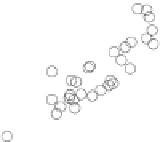Geoscience Reference
In-Depth Information
80
A
60
E1
E2
E3
E4
E5
R6
R7
R8
R9
R10
R11
R12
R13
R14
W16
R20
R23
R24
R26
R27
40
20
0
−20
−50
0
50
100
150
200
250
300
350
Scores on PC 1 − 94.1 %
0.1
B
0.05
0
−0.05
−0.1
−0.15
−0.15 −0.1 −0.05
0
0.05
0.1
0.15
0.2
0.25
0.3
Scores on PC 1 − 65.3 %
Figure 10.4. Principal components analysis of the Horsens catchment data set showing the effect of
different preprocessing methods on model scores. (A) Auto-scaling. (B) Row normalization followed
by mean centering. (See Plate 15.)
sources. Wedborg et al. (
2007
) showed that a humic-like fluorescent component in the
Southern Ocean correlated with salinity, density and total inorganic carbon along the first
principal axis highlighting its refractory nature, while along the second principal axis, two
protein-like fluorescence components correlated strongly with each other and negatively
with temperature and nitrate. Chen et al. (
2010
) used PCA on nine fluorescence compo-
nents in surface and groundwaters of the Florida coastal Everglades and wetlands to show
separation between samples from two surface and two groundwater sources. Terrestrial-
humic and protein-like components lay at opposite ends of the first principal axis, while
at opposite ends of a second principal axis apparently describing photo- and microbial-
degradation were two short-emission humic fluorescence components. PCA has also been
used to analyze DOM fluorescence and its interaction with process variables and plant
performance in water treatment facilities (Antunes et al.,
2007
; Lu et al.,
2009
; Peiris et al.,
2010
). Typically, published studies involving PCA analyses of CDOM fluorescence data




















































































































































































































































































































































































































